Out walking this morning I see that there are a lot of items of plastic washed up in our coastal areas. The recent storms and high tides have carried many items onto the sand and stones. While we do see some larger items due to intentional dumping from time to time, much of what arrives on our shores, comprises debris, plastic bottles or parts of them, fishing net, syringes, tyre rubber, the list goes on – and the sizes are typically quite small, indicating that they have been eroded and broken down in the process from source to sea, and back. The sight is not a pretty one. Many of these plastics are further eroded into what we know as microplastic and even nanoplastic on the journey.
 Identifying the source of microplastic contamination is difficult. One reason for this is that the majority of research carried out on microplastics has been on seawater. Whereas it is likely that a large percentage of microplastics enter the oceans through freshwater systems such as rivers. Studies suggest that 80% of microplastics found in oceans originate from terrestrial activities, such as waste dumping, plastic processing and transport, waste water treatment plants and many more activities. Therefore to better understand how and where microplastics are coming from, it is necessary to increase research on microplastic concentration in freshwater systems.
Identifying the source of microplastic contamination is difficult. One reason for this is that the majority of research carried out on microplastics has been on seawater. Whereas it is likely that a large percentage of microplastics enter the oceans through freshwater systems such as rivers. Studies suggest that 80% of microplastics found in oceans originate from terrestrial activities, such as waste dumping, plastic processing and transport, waste water treatment plants and many more activities. Therefore to better understand how and where microplastics are coming from, it is necessary to increase research on microplastic concentration in freshwater systems.
Our citizen science work in 2019/20 has shown that by studying plastics in the freshwater environment – in rivers and streams, can help with the prevention of plastic litter reaching the sea and having the detrimental effects on fish and marine mammals, that we are so familiar with. We have been working on a citizen science project for a year now, the Backdrop project. This project studies water quality and litter in the R. Liffey and we plan to expand this activity across the country. We can see that identifying plastic hotspots can be a useful way to address litter collection as well as understanding the route that plastic takes from Source to Sea.


If you are interested in getting involved in the current or future citizen science work, please get in touch. Follow us on twitter @dcuwater to see results of the work that our amazing citizens are doing.
Gallery




Recent Comments